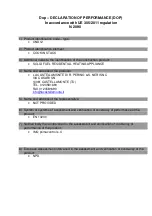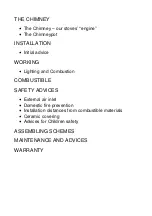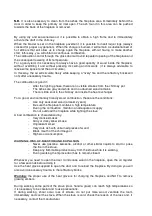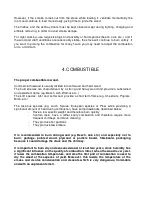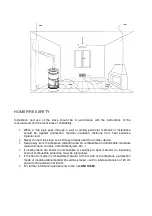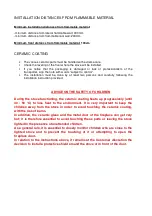
N.B.
It is also necessary to clean from the ashes the fireplace area immediately behind the
door in order to keep the primary air inlet open. The ash found in this area can be pushed
towards the back of the fireplace or removed.
By using dry and seasoned wood, it is possible to obtain a high flame and to immediately
activate the draft in the chimney.
When the brazier is set on the fireplace pavement, it is possible to insert larger logs (always
crossed for proper oxygenation). When the charge is burned, it will remain a substantial bed of
hot embers that will allow us to charge again the fireplace, without having to make another
start; inthis way, you will obtain a continuous combustion.
The combustion control through the glass door will avoid repeated opening of the fireplace and
the consequent lowering of its temperature.
For a good yield, it is necessary to always have a good quantity of wood inside the fireplace;
without overfilling it and without pressing its ceiling and its walls (it is always advisable to
leave some space to let the air circulate).
In this way, the air will circulate freely while keeping a “lively” fire and the refractory bricks will
not suffer unecessary trauma.
The combustion is good if:
-
After the lighting phase, there are no visible smokes from the chimney pot.
-
The ashes are gray and white and no unburned wood remains.
-
There is little soot in the chimney and inside the heat exchanger.
For a good, environmentaly friendly wood combustion, these are the conditions :
-
Use only seasoned wood (at least 2 years)
-
Be sure the fireplace maintains a high temperature
-
During the combustion maintain an adequate air supply
-
Do not overload the fireplace while lighting the stove
A bad combustion is characterized by:
-
Very dense smokes
-
Gray or dark yellow smoke
-
Unpleasant smell
-
Very dark ash with unburned pieces of wood
-
Black mouth of the chimneypot
-
High wood consumption
WARNING: RISK OF BACKFIRE AND EXPLOSION
-
Never use gasoline, kerosene, alcohol or other similar liquids to start or poke
the fire in the stove.
-
Keep any flammable product away from the stove while it is working.
-
During working the firplace door has to remain closed.
Whenever you need to open the door to introduce wood in the fireplace, open the air register
for a few seconds before doing it.
Use the heat glove supplied to open the door and to reload the fireplace. By doing so you will
also avoid unecessary trauma to the reffractory bricks.
Warning:
the proper use of the heat glove is for charging the fireplace and NOT to remove
glowing embers.
During working, some parts of the stove (door, handle, glass) can reach high temperatures so
it is necessary to be careful and to use precautions.
If during working, shoul occur loss of smoke, do not put more wood, ventilate the room
immediately and cool the stove. When the stove is cold, check the reason of the loss and, if
necessary, contact the manufacturer.
Summary of Contents for COOKIN STACK
Page 6: ...FIG 2 A FIG 2 B FIG 2 C ...
Page 8: ...FIG 2 E ...


